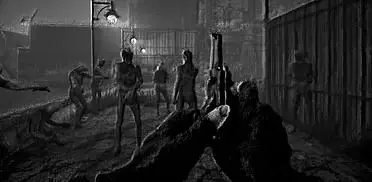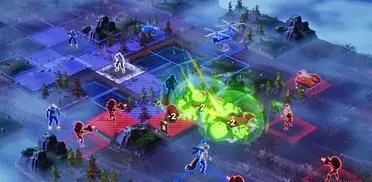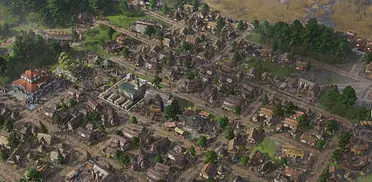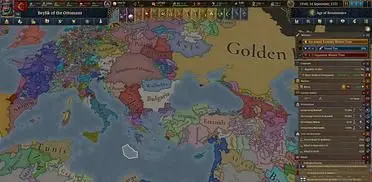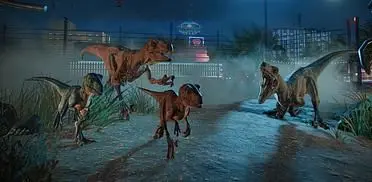The most destructive war ever fought was the second world war. From the fields of Europe to the seas of the pacific, huge armies and fleets struggled for world domination. The fate of nations and empires hung on these battles in the air, on the ground, and in the seas. Such an epic struggle certainly deserves a simulation worthy of it, and their have been no shortage of attempts as war as WW II is concerned. Gary Grigsby's World at War is another entry in this genre, and it may be the first to actually fill the bill as a simulation of grand strategy of the second World War.
World at War is a turn based grand strategy game of the Second World War. Players can select one of five factions that took part in WWII; The Nazis, the Western Powers, Japan, Soviet Union and China. Smaller powers are combined into the five groupings, so the Italians are part of the Nazis, and all of the Allied nations are one faction, Britain, France, and Later the USA. Each power is historically rated as to the units, ships and airpower it had available at the start of the campaigns offered. Players can begin in 1940, 1941, 1942 and 1943. Each start date has its own unique challenges and goals for players to handle .
The game map of WaW is devided into areas, and each area has a number of ratings, including its rail capacity, industrial capability, and so on. These things can be both damaged and repaired, using repair points. An interesting feature is the locked nations, countries not yet at war, or neutral, are locked, meaning they have no immediate effect on play. Neutrals can be invaded, and locked major powers may enter the war within an historical time frame, or if certain criteria are met. For example, if the Nazis leave Poland unoccupied, a greedy Stalin may attack. The Nazis may attack it whenever they like, but it will enter the war at some point, no matter what.
The game includes a unit production system, and a research tree for producing better units, and adding additional capabilities, but the paths of this tree are not limitless. You cannot research everything, there simply isn't time, and most nations must concentrate on what they need to win the war. The players can let the game system handle this, as many feel production is minutia, but the war can be both won and lost by poor research and production. Armies and navies also need food and fuel, and you have to produce supplies and maintain lines of communication to keep your war machine functioning.
Movement is by area, each moving unit consumes supply to move within your territory and when attacking other areas. Some units types can move addition areas, armor can move two areas, and air power can range much further. There are also airborne forces, heavy bombers, all the unit types one would expect to see in the second world war. The game also includes strategic movement, both by sea and by railroad. This consumes no supply, but is limited to your sea and rail capacity. This type of movement can be a life saver, as critical units can swiftly arrive at far flung points to turn the tide of battle in your favor.
Combat is calculated within the game by 'die rolls' that are modified by unit types, research equipment levels, terrain, and many other factors. The game provides the odds of combat based on the force used, but combat in this game can be tricky. If you attack with many units, you may be leaving the area you attacked from vulnerable to counter attack from other areas. You simply must plan your campaigns carefully to get the most out of this game system. The old 'build lots of tanks and crush them' won't work, as the enemy will have taken your nation before the first super panzer comes into service.
The game's AI is a strong point, winning is not an easy task for any power. The computer is aggressive and will look for weakness in a player's positions. It also has a nasty habit of activating nations in areas you think are safe, and secure. The AI also knows which units work best in certain types of terrain, and tries to utilize them there. This type of interactive opponent makes the single player campaign worthwhile, and its much better then other World war two games that are currently on the market.
The look of the game is very much like the board games of old, different colors are used for each faction, and disks showing the national emblem of a faction are highlighted for fleets at sea. The battles are two dimensional, units sit there and fire colored lights at each other, while the AI calculates combat. There is some animation, bombers will drop bombs, ship will bombard, but the battle screen isn't a strength of the game. There are numerous and detailed subscreens for production and movement, all very detailed with a wealth of information.
The musical track of the game is quite good, and gives a nice World War Two feel. The game also includes newspapers head lines when key events happen, like the fall of Paris for example. These give a nice historical flavor to the game, and provides a good atmosphere for players. Such little touches add a lot to wargames, and more game designs should include these little touches, as they add much and cost little in design and effort.
Overall, this is an excellent World War Two wargame, and I stress wargame here. This isn't kid stuff, like some of the currently popular WWII games, and it won't be easy to win as Germany, the way its number one competitor's design allow. You have to earn the victory here, by planning and smart decision making, not by having it handed to you by the hero worship of the German Military others designs are often hung up on. The graphics aern't fancy, but they are functional, and the game is fun and challenging. If you want to play a game about World War two, play World At War.
GARY GRIGSBY’S WORLD AT WAR VERDICT
Click on the picture to enlarge it Overall, this is an excellent World War Two wargame, and I stress wargame here. This isn’t kid stuff, like some of the currently popular WWII games, and it won’t be easy to win as Germany, the way its number one competitor’s design allow. You have to earn the victory here, by planning and smart decision making, not by having it handed to you by the hero worship of the German Military others designs are often hung up on. The graphics aern’t fancy, but they are functional, and the game is fun and challenging. If you want to play a game about World War two, play World At War.





